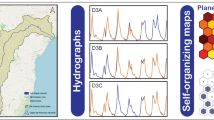Abstract
Earth Observation (EO) Data Cubes infrastructures model analysis-ready data generated from remote sensing images as multidimensional cubes (space, time and properties), especially for satellite image time series analysis. These infrastructures take advantage of big data technologies and methods to store, process and analyze the big amount of Earth observation satellite images freely available nowadays. Recently, EO Data Cubes infrastructures and satellite image time series analysis have brought new opportunities and challenges for the Land Use and Cover Change (LUCC) monitoring over large areas. LUCC have caused a great impact on tropical ecosystems, increasing global greenhouse gases emissions and reducing the planet’s biodiversity. This paper presents the utility of Self-Organizing Maps (SOM) neural network method in the process to extract LUCC information from EO Data Cubes infrastructures, using image time series analysis. Most classification techniques to create LUCC maps from satellite image time series are based on supervised learning methods. In this context, SOM is used as a method to assess land use and cover samples and to evaluate which spectral bands and vegetation indexes are best suitable for the separability of land use and cover classes. A case study is described in this work and shows the potential of SOM in this application.
Access this chapter
Tax calculation will be finalised at checkout
Purchases are for personal use only
Similar content being viewed by others
References
Nativi S, Mazzetti P, Craglia M (2017) A view-based model of data-cube to support big Earth data systems interoperability. Big Earth Data 1:75–99
Lewis A, Oliver S, Lymburner L, Evans B, Wyborn L, Mueller N, Wu W (2017) The Australian geoscience data cube — foundations and lessons learned. Remote Sens Environ 202:276–292
Soille P, Burger A, De Marchi D, Kempeneers P, Rodriguez D, Syrris V, Vasilev V (2018) A versatile data-intensive computing platform for information retrieval from big geospatial data. Future Gener Comput Syst 81:30–40
FAO: Sepal repository (2018). https://github.com/openforis/sepal. Accessed 14 Dec 2018
Suepa T, Qi J, Lawawirojwong S, Messina P (2016) Understanding spatio-temporal variation of vegetation phenology and rainfall seasonality in the monsoon Southeast Asia. Environ Res 147:621–629
Pasquarella J, Holden E, Kaufman L, Woodcock E (2016) From imagery to ecology: leveraging time series of all available landsat observations to map and monitor ecosystem state and dynamics. Remote Sens Ecol Conserv 2(3):152–170
Gomez C, White C, Wulder A (2016) Optical remotely sensed time series data for land cover classification: a review. J Photogram Remote Sens 116:55–72
Bagan H, Wang Q, Watanabe M, Yang Y, Ma J (2005) Land cover classification from Modis EVI time-series data using SOM neural network. Int J Remote Sens 26:4999–5012
Siam L (2013) Soft supervised self-organizing mapping (3SOM) for improving land cover classification with MODIS time-series. PhD thesis, Michigan State University, Michigan
Maus V, Camara G, Cartaxo R, Sanchez A, Ramos M, Queiroz G (2016) A time-weighted dynamic time warping method for land-use and land-cover mapping. IEEE J Sel Top Appl Earth Observ Remote Sens 9(8):3729–3739
Huete A, Didan K, Miura T, Rodriguez E, Gao X, Fereira L (2002) Overview of the radiometric and biophysical performance of the MODIS vegetation indices. Remote Sens Environ 86:195–213
Picoli M, Camara G, Sanches I, Simoes R, Carvalho A, Maciel A, Coutinho A, Esquerdo J, Antunes J, Begotti R, Arvor D, Almeida C (2018) Big Earth observation time series analysis for monitoring Brazilian agriculture. ISPRS J Photogram Remote Sens 145:328–339
Boles H, Xiao X, Liu J, Zhang Q, Munktuya S, Chen S, Ojima D (2004) Land cover characterization of temperate East Asia using multi-temporal vegetation sensor data. Remote Sens Environ 90(4):477–489
Udelhoven T, Stellmes M, Rodes A (2015) Assessing rainfall-EVI relationships in the Okavango catchment employing MODIS time series data and distributed lag models. In: Revealing land surface dynamics. Remote sensing time series. Springer, Cham, pp 225–245
Wehrens R, Buydens L (2007) Self and super-organizing maps in R: the Kohonen package. J Stat Softw 21:1–19
Camara G, Simoes R, Andrade P, Maus V, Sanchez A, Assis L, Santos L, Ywata A, Maciel A, Vinhas L, Ferreira K, Queiroz G (2018) Sits e-sensing/sits: Version 1.12.5, December 2018. https://doi.org/10.5281/zenodo.1974065
Author information
Authors and Affiliations
Corresponding author
Editor information
Editors and Affiliations
Rights and permissions
Copyright information
© 2020 Springer Nature Switzerland AG
About this paper
Cite this paper
Santos, L., Ferreira, K.R., Picoli, M., Camara, G. (2020). Self-Organizing Maps in Earth Observation Data Cubes Analysis. In: Vellido, A., Gibert, K., Angulo, C., Martín Guerrero, J. (eds) Advances in Self-Organizing Maps, Learning Vector Quantization, Clustering and Data Visualization. WSOM 2019. Advances in Intelligent Systems and Computing, vol 976. Springer, Cham. https://doi.org/10.1007/978-3-030-19642-4_7
Download citation
DOI: https://doi.org/10.1007/978-3-030-19642-4_7
Published:
Publisher Name: Springer, Cham
Print ISBN: 978-3-030-19641-7
Online ISBN: 978-3-030-19642-4
eBook Packages: Intelligent Technologies and RoboticsIntelligent Technologies and Robotics (R0)




